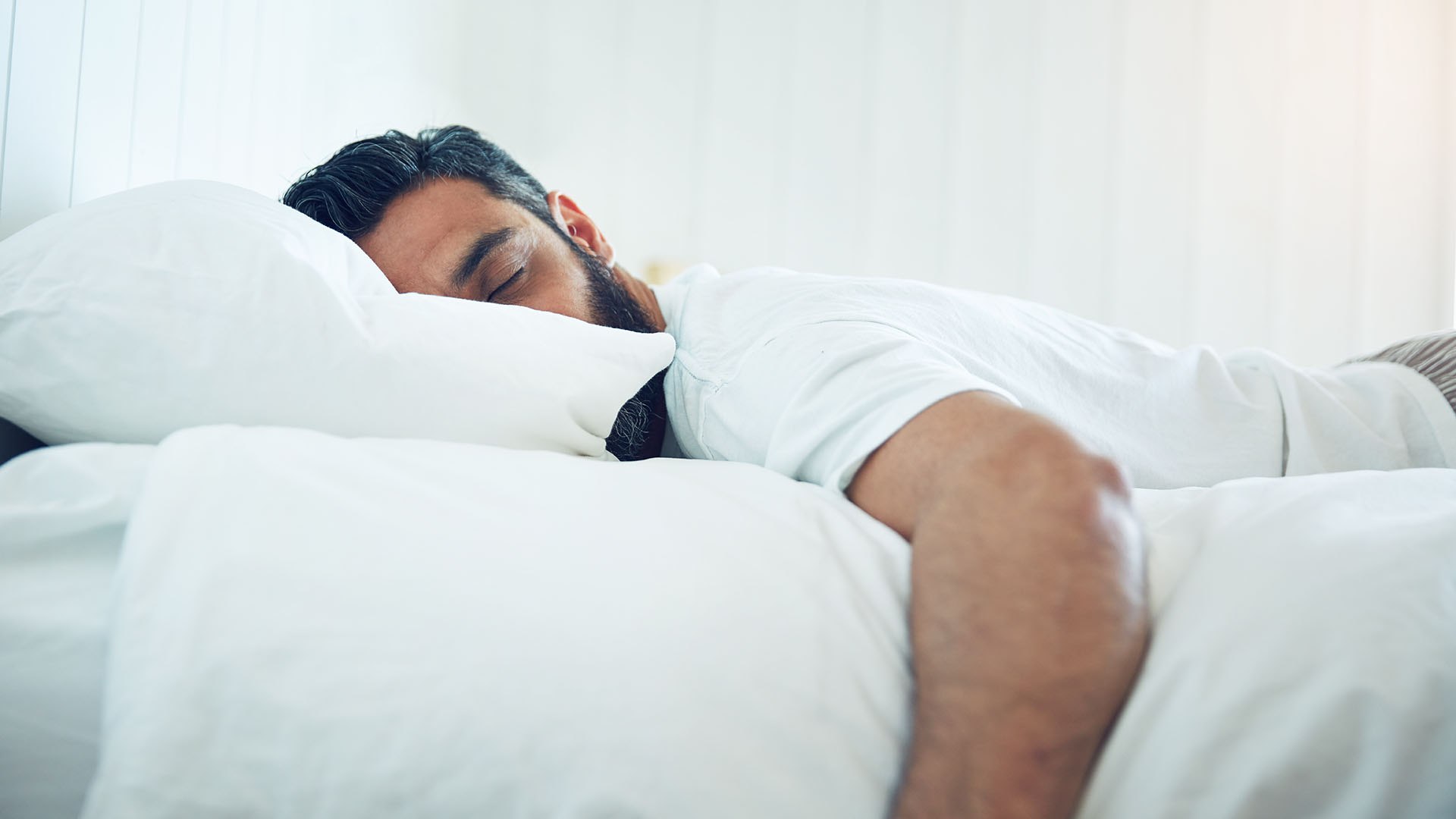Do stomach sleepers need a pillow? Yes, and a chiropractor explains which type
How to choose the best pillow for stomach sleepers, according to a chiropractor

We all have our innate preferences for everything - and our preferred sleeping positions are no different. Some people may gravitate towards stomach sleeping. However, this position heightens the chances of spinal misalignment—and ensuing aches, pains, and stiffness—as well as a poor night’s rest.
If you can’t help but sleep in this position, it’s important you know which is the best pillow for stomach sleepers, as well as which is the best mattress for healthy spine alignment.
Keep reading to discover why stomach sleeping is ill advised to begin with, according to a chiropractor. Plus: top tips for pillows that stomach sleepers should adopt ASAP.
- Read more: Saatva Latex Pillow review 2024
Is sleeping on our stomach unhealthy?
Stomach sleeping is often cited as the most flawed sleeping position. Rubina Tahir, DC, a chiropractor in Ann Arbor, Michigan, offers an analogy to illustrate why it spells bad news for your spine.
“Would you walk around all day with your head turned to one side?” she asks. Naturally, the answer is no, so you shouldn’t sleep that way either. “[Keeping your] head rotated all the way to one side is known as an extreme end range type of posture,” she continues. “There is a high risk of joint pain when your neck is held at the extreme of its normal range of motion for prolonged periods (aka hyperextension with rotation). A similar example is keeping your head down while texting, resulting in ‘tech neck.’

As a 2019 review in the journal BMJ Open explains, stomach sleeping in what’s referred to as a ‘prone’ position is clinically suggested to “increase load on spinal tissues, reducing recovery and provoking waking spinal symptoms.”
In addition, Dr. Tahir says that stomach sleeping heightens the chances of nighttime waking and morning stiffness.
Get instant access to breaking news, the hottest reviews, great deals and helpful tips.
These points considered, stomach sleeping may offer a built-in perk for a major demographic. In case you’re among the estimated 37 million chronic snorers in the United States, you may find that this sleeping position mitigates this condition. “Those who snore often find sleeping on their stomach an easier position to fall asleep in with less snoring,” the chiropractor notes.
Do stomach sleepers need a pillow?
Stomach sleepers should generally sleep with a pillow—so long as it’s in the correct form and proper position. If you can’t resist the urge to sleep on your stomach, Dr. Tahir advises making strategic pillow choices to minimize potential hazards.
“While stomach sleeping should be avoided—back or side sleeping is best—it is important to know that a high pillow can increase the end range of motion of the neck to a high degree and accelerate wear and tear on joints,” she warns. (She calls out feather pillows as one type that’ll be too high.) As such, thin pillows are more ideal for stomach sleepers since they’ll reduce the incline of your neck’s position and thus cause less strain.
In addition, you’ll need to be mindful of how and where you position your arms. “You want to make sure that you don’t rest your head on your arm or position your arm underneath the pillow,” she advises. Making this mistake “will increase compressive forces on your forearm and lead to numbness and tingling.”
How to choose the best pillow for stomach sleepers

If you're looking for the best pillow for stomach sleepers in order to maintain optimum neck and spine health, be sure to heed the following chiropractor-approved tips:
Consider a contour pillow. “Contour pillows will provide some neck support and allow the head to rest in a more forward position compared to the neck. This is best if you must sleep on your stomach,” Dr. Tahir explains.
Choose your pillow material wisely. The chiropractor suggests opting for pillows consisting of shredded memory foam and microfiber clusters. “This will allow the pillow to mold to your body,” she says.
Avoid pillows that are too firm. Firm pillows, she continues, are likely to create an uncomfortable angle for the cervical spine in stomach sleepers. The right firmness level is one of the reasons stomach sleepers should be super fussy about their pillows.
Avoid log pillows. According to Dr. Tahir, the shape of log pillows won’t offer adequate support; chances are you’ll wake intermittently throughout the night in search of a more comfortable position.
How to sleep on your stomach: 5 dos and don’ts
It’s one thing to know that sleeping on your stomach is far from ideal for your neck, shoulders, and back. However, it’s not always so simple to actually avoid this sleeping position if it’s your go-to. What that in mind, Dr. Tahir offers a few parting tips for stomach sleepers worth adopting.
Do: Sleep on a mattress with the right tension and firmness level
To prevent your spine from dipping out of alignment, investing in the best mattress for stomach sleepers is key. “Medium-firm mattresses provide support for the joints of the entire body,” Dr. Tahir shares. She specifically recommends pocket coil and memory foam mattresses, saying they’re less likely to sag and accelerate wear and tear.
Don’t: Stack pillows
Just as stomach sleepers should avoid resting on a firm, high pillow, they should take care to sleep on one thin pillow only. “Stacking pillows will compress the joints of your neck,” Dr. Tahir warns, which will ultimately cause prolonged stress. “While it may feel good at the start of your night, this is because your skeletal muscles are in an active phase. However, sleep is a time of skeletal muscle inactivity, and thus pressure points are subjected to different forces.”
In short, stacking pillows is a no-go for stomach sleepers—which your body will likely try to communicate to you via nighttime awakenings.
Do: Start the night laying on your back or side

“Sleep posture is part of the model of decreasing unnecessary pressure on the discs and joints of the spine,” shares Dr. Tahir. Back and side sleeping are preferred since they support proper alignment and thus help keep aches, stiffness, and more serious injury at bay.
Again, changing your sleep position is easier said than done—but it’s not impossible. “Training your body to sleep in a different position takes practice. It takes two weeks to 30 days to notice a significant change,” says Dr. Tahir. However, it’ll be well worth the effort in the long run. “The less time you spend sleeping on your stomach, the better.” While you may continue to wake up on your stomach, it’s still in your best interest to try phasing out of this position.
Don't: Ignore worsening pain
Don't ignore worsening pain to avoid lasting wear and tear. Instead, consulting a local chiropractor can help stomach sleepers establish a healthier path and build more sustainable habits. “A chiropractor will examine your posture and the current health of your joints. [They’re] trained to offer suggestions that are best for neck and back health,” Dr. Tahir explains.
If needed, they’ll perform adjustments that can alleviate pressure from joints that are regularly held at extreme ranges of motion (i.e., stomach sleeping). “Patients typically notice an improved ability to turn and tilt the head and a reduction of pain, soreness, and stiffness,” she continues. Another bonus: “Getting regular adjustments will help you ease into side sleeping and back sleeping because it will feel more comfortable for you.”
Do: Investigate trial periods and return policies
Dr. Tahir says it’s hard to test pillows in an active muscle phase. To protect your buck and body alike, she suggests prioritizing pillow and mattress brands with a favorable trial period and/or return policy.
Michele Ross is a freelance writer based in Los Angeles. For Tom's Guide and TechRadar, she interviews medical experts for sleep tips and tricks, as well as reviews mattresses and toppers to see which ones are truly worth buying for different types of sleepers and budgets. She has also covered a range of sleep topics for publications and brands including Well+Good, HUM Nutrition, and Mini Bloom, among others.

